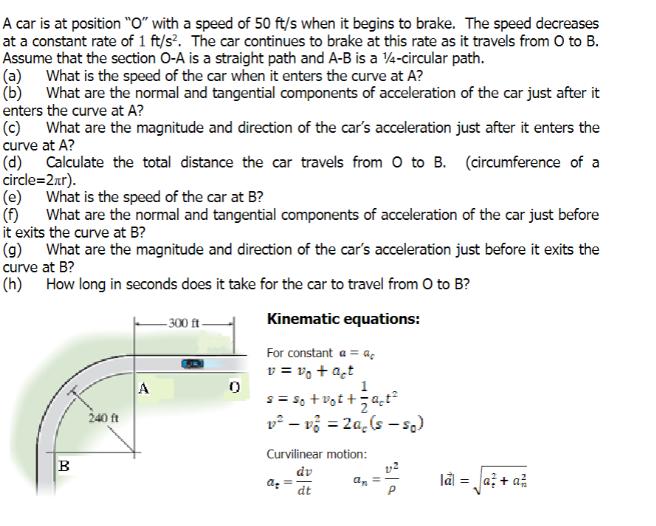Answered step by step
Verified Expert Solution
Question
1 Approved Answer
A car is at position O with a speed of 50 ft/s when it begins to brake. The speed decreases at a constant rate

A car is at position "O" with a speed of 50 ft/s when it begins to brake. The speed decreases at a constant rate of 1 ft/s. The car continues to brake at this rate as it travels from O to B. Assume that the section O-A is a straight path and A-B is a 14-circular path. (a) What is the speed of the car when it enters the curve at A? (b) What are the normal and tangential components of acceleration of the car just after it enters the curve at A? (c) What are the magnitude and direction of the car's acceleration just after it enters the curve at A? (d) Calculate the total distance the car travels from O to B. (circumference of a circle=2xr). (e) What is the speed of the car at B? (f) What are the normal and tangential components of acceleration of the car just before it exits the curve at B? (g) What are the magnitude and direction of the car's acceleration just before it exits the curve at B? (h) How long in seconds does it take for the car to travel from O to B? Kinematic equations: B 240 ft A -300 ft- 0 For constant ac v = v + at 1 s = so + vot += act vv = 2a, (s-so) Curvilinear motion: dv dt 3 P lal = a + a 2
Step by Step Solution
There are 3 Steps involved in it
Step: 1
a The speed of the car when it enters the curve at A can be calculated using the equation v vo 2as where v is the final speed vo is the initial speed ...
Get Instant Access to Expert-Tailored Solutions
See step-by-step solutions with expert insights and AI powered tools for academic success
Step: 2

Step: 3

Ace Your Homework with AI
Get the answers you need in no time with our AI-driven, step-by-step assistance
Get Started


